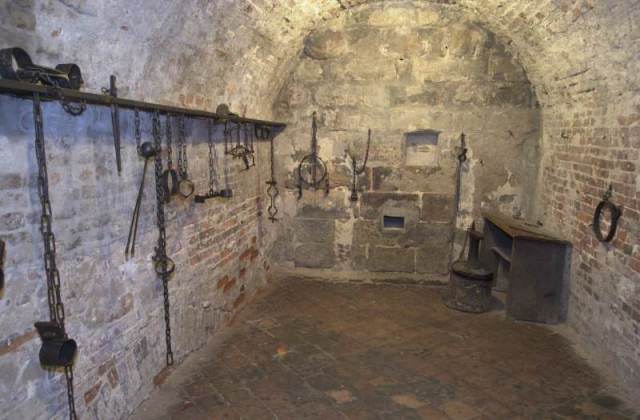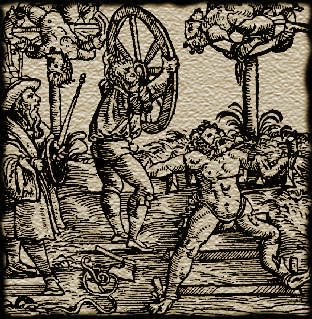In 1553, a wood-cutter named Heinrich Schmidt was standing amongst a crowd in the Bavarian town of Hof, listening to the Margrave detail a plot to assassinate him. The Margrave had arrested three men and accused them of the crime. Now it was time to execute them. There was no official executioner handy, so the Margrave invoked a local custom: he pointed at Heinrich and ordered him to do the deed. The wood-cutter was reluctant but was told that if he refused to carry out the order, then he would be executed instead as well as the men standing on either side of him. So Heinrich Schmidt picked up a sword and cut the heads off the three men.
Having killed these men, Schmidt became a social outcast, like a gravedigger or a slaughterhouse worker, the kind of workers that are called burakumin in Japan and shunned to this day. So Schmidt turned to the only job opening available for a man like himself — he became an official executioner. Two years later, his son, Frantz, was born and, when he was old enough, became his father’s apprentice.
“Leonardt Russ of Ceyern, a thief. Executed with the rope at the city of Steinach. Was my first execution.” So begins the diary of Frantz Schmidt which details his life’s work as an executioner and torturer, first under his father, then in Nuremburg. Over the course of forty-five years, Frantz Schmidt executed 361 people and tortured hundreds more. These acts were all noted in his diary. He was proficient in using the noose, the wheel, fire, and drowning besides the sword, which was considered the most merciful of execution methods.
![The only known picture of Schmidt. "Execution of Hans Fröschel, 1591". This drawing was made in the marguns of a court record book. Note Schmidt's collar and curved moustache. [WikiMedia Commons]](http://shrineodreams.files.wordpress.com/2013/08/schm_exe.jpg?w=640)
The only known picture of Schmidt. “Execution of Hans Fröschel, 1591″. This drawing was made in the margins of a court record book. Note Schmidt’s collar and curved moustache. [WikiMedia Commons]
Five years after hanging his first man, Schmidt took up work in Nuremburg. He first served as assistant to Nuremburg’s chief executioner, then succeeded him. He also married his master’s daughter — both husband and wife being tainted by association with one of the nastier trades, they would have had difficulty finding a spouse elsewhere. But the post of chief executioner was well-paid and the Schmidt family lived in an upscale part of the city.
A public execution was staged as a morality play. In the first act, the prisoner — whose guilt had already been determined — was allowed a last meal, including alcohol, then was dressed in a white blouse. The executioner then entered and asked the prisoner’s forgiveness before sharing a traditional drink with him. During this time the executioner would be assessing the prisoner’s state of mind and health, judging when he was ready to proceed.

Dungeon under Nuremburg’s Old City Hall. Here is where prisoners were held before their execution. Now it’s a tourist destination.
Now the prisoner was brought before a “blood court” consisting of a robed judge holding a rod and a sword, and twelve jurors. The judge would read out the death sentence, including the method of execution, then poll the jurors for their assent. “What is legal and just pleases me,” each would reply. Next the judge asked if the prisoner wished to speak. This was an opportunity for the prisoner to forgive those who had condemned him to death and possibly express his thanks, especially if the sentence was for a merciful beheading. Some prisoners might curse the court, others were too dumb with fear or stupefied by drink to make a coherent speech. When the prisoner was finished speaking, the judge would order the executioner to carry out the sentence and snap in two the white rod he was holding.
The second act of this drama was a procession to the place of execution, which might be a mile or two away. The judge led the way, followed by the prisoner, a couple of soldiers, a chaplain or two, and the executioner and his assistants. Sometimes, if the prisoner was violent or was sentenced to be tortured on the way, he would be carried in a cart. Tortures might include having pieces of flesh torn out with red-hot tongs. The number of these “nips” were spelled out in the sentence. Sometimes the prisoner would have a few more drinks along the way.
The procession route would be lined by crowds of people, who might themselves be drunk and unruly and sometimes threw things at the prisoner. If he could, Schmidt would hurry the prisoner along to avoid problems. The prisoner might pray along with the chaplains and bless the crowd or he might curse his audience or break down in tears.

Execution by wheel. The man’s limbs are being broken with heavy wheels. This is opposed to execution on a wheel, where the limbs were broken by a rod or weight after the victim was strapped to a wheel.
The final act was the execution itself. The condemned prisoner would mount a scaffold or a platform. There, it was expected that a final prayer would issue from his lips as the noose was placed around his neck or as he sunk to his knees and awaited the executioner’s sword. The executioner would perform the deed then turn to the judge:
“Lord Judge, have I executed well?”
“You have executed as judgment and law have required.”
“For that I thank God and my master who has taught me such art.”
Then the executioner and his assistants would clean up and dispose of the remains.
No executioner wanted to make a mistake that would sully the grand pageant of death. Though messy executions were frequent at this time, Frantz Schmidt seldom took more than one stroke of the sword to remove a head. Out of 187 decapitations, only four needed more than a single blow. Schmidt was unforgiving to himself for these four, writing in his diary that he had botched the job and did not try to excuse himself. He was proud to practice his trade well. His headsman skill was at least partly due to the fact that he did not drink — at this time executioners were often as drunk as their prisoners when they wielded their sword.
![German executioner's sword. The inscription: “I have to punish crime as the law and judge tell me”. [Weapons Universe]](http://shrineodreams.files.wordpress.com/2013/08/schm_sword.jpg?w=640)
German executioner’s sword. The inscription: “I have to punish crime as the law and judge tell me”. [Weapons Universe]
Women were not executed as often as men but repeated offenses might well wind up with a capital sentence. So, Marie Kurschnerin, a prostitute, was pilloried in the stocks and driven out of town. Further offenses brought the punishment of having her ears cropped. Finally, in 1584, Schmidt’s wrote in his diary:
…the thief and whore Marie Kurschnerin, together with thievish youths and fellows, had climbed and broken into citizens’ houses and stole a mighty quantity of things. It was an unheard of thing for a woman to be hanged in this city and it had never happened before. Such a dreadful crowd ran out to see this, that several people were crushed to death.
An entry from Schmidt’s diary for 1617:
November 13th. Burnt alive here a miller of Manberna, who however was lately engaged as a carrier of wine. Because he and his brother, with the help of others, practiced coining and counterfeiting money and clipping coins fraudulently. He also had a working knowledge of magic… This miller, who worked in the town mills here three years ago, fell into the town moat on Whitsunday. It would have been better for him if he had been drowned, but it turned out according to the proverb that “What belongs to the gallows cannot drown in water.” This was the last person whom I, Master Frantz, executed.
Frantz Schmidt served the city of Nuremburg for forty years. He successfully petitioned the emperor to allow his children to have the executioner stigma removed from their names so that they could pursue other trades. After his retirement in 1617, Schmidt served as a healer for the last seventeen years of his life. Ironically, during that period most of his children and grand-children, that he had saved from practicing his deadly craft, died. When Frantz Schmidt himself followed them in 1634, Nuremburg honored him with a grand funeral. Social outcast though he was, Schmidt was also well-respected.
Notes:
The main source for all the above is Joel Harrington’s The Faithful Executioner: Life and Death, Honor and Shame in the Turbulent Sixteenth Century , a really interesting book.
, a really interesting book.
Some odd points were picked up from an interview with Harrington and a few items from this article on medieval executions of women which includes an interesting account of the execution by Schmidt of Elizabeth Aurhaltin, aka Scabby Beth.
Schmidt’s original diary long ago disappeared but at least four copies of it were made. Harrington used the earliest copy known as the basis for his book. A 1928 English translation from another copy is a prime candidate for the Internet Archive or Gutenberg.org. Somebody out there hear me.
Also, in this context, I can’t help recommending Gene Wolfe’s The Book of the New Sun tetralogy featuring Severian, apprentice to the Seekers for Truth and Penitence, which is to say, the Torturers’ Guild.
tetralogy featuring Severian, apprentice to the Seekers for Truth and Penitence, which is to say, the Torturers’ Guild.